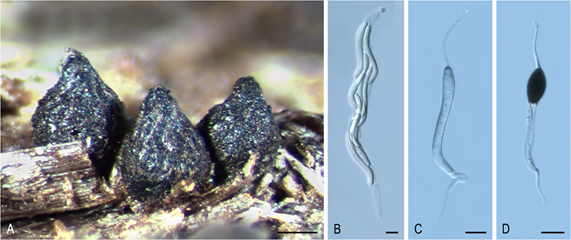Areotheca Y. Marín & Stchigel, in Marin-Felix, Miller, Cano-Lira, Guarro, García, Stadler, Huhndorf & Stchigel, Microorganisms 8(9, no. 1430): 13 (2020)
Index Fungorum number: IF 835497; Facesoffungi number: FoF14638
Etymology – The name refers to the areolate ascomatal wall.
Sexual morph Ascomata ostiolate, scattered or aggregated, superficial, ovoid, glabrous or covered with flexuous, septate hairs; neck conical, ridged, carbonaceous. Ascomatal wall pseudoparenchymatous, blackish brown, carbonaceous, opaque, areolate, cephalothecoid, 2–3 layered; outer ascomatal wall cells prismatic; intern layers composed of flattened cells. Paraphyses filiform-venticrose. Asci unitunicate, eight-spored, narrowly clavate or cylindrical, non-amyloid, apical ring thickened, with or without subapical globulus. Ascospores biseriate or multiseriate, at first one-celled, hyaline, cylindrical, vermiform, slightly sigmoid or bent in one end, later swelling above, becoming transversely uniseptate; upper cell brown, ellipsoidal to pyriform, more or less equilateral, smooth-walled, truncate at base, with a subapical germ pore, sometimes with one or more transverse septum; lower cell hyaline to pale brown, cylindrical, geniculate below, collapsing with age, without septa or 3–5-septate; gelatinous cauda absent or present, lash-like, attached at one or both ends of the ascospore. Asexual morph absent or present. Conidiophores reduced to conidiogenous cells. Conidiogenous cells phialidic, hyaline, arising directly from ascospores, normally from the lower cell, rarely branched. Conidia hyaline, globose, smooth-walled.
Type species – Areotheca ambigua (R. Hilber) Y. Marín & Stchigel.
Notes – The main distinctive feature of Areotheca is its carbonaceous, areolate, cephalothecoid ascomatal wall. In this regard, other taxa in the Sordariales produce this type of ascomatal wall: Cladorrhinum coprophilum (syn. C. coprophila) shows indistinct areoles, whereas they are more obvious in C. caerulea, C. septentrionalis, C. silvatica, and T. striata (syn. C. striata). However, these particular structures are fully developed and carbonaceous in Ar. areolata. Another important morphological feature is the septation of the upper cell, present only in the genus Naviculispora and some species (Bellojisia rhynchostoma, C. sulphurella, Corylomyces selenospora, Podospora dydima, and Zopfiella tabulata) included in the Lasiosphaeriaceae s. str., and Zopfiella pleuropora (of clade VI). Finally, Areotheca is distinguished from other genera in the family by its ascospores with a basal cell up to twice as long as the upper cell. The two species of Areotheca are mainly differentiated by the size of their ascospores (the upper cell measures 20–27 × 8–11 µm in Ar. ambigua and 15–18 × 7–10 µm in Ar. areolata; the lower cell measures 35–55 × 6–7 µm in Ar. ambigua and 25–32 × 4–5 µm in Ar. aerolata), and by the presence of several septa in the lower ascospore cell of Ar. ambigua, absent in Ar. areolata.

Figure 3. Areotheca areolata JF05120_ANMAcc49. (A) Ascomata. (B) Ascus. (C,D) Ascospores. Bars: (A) = 200 µm; (B–D) = 10 µm.
Species
